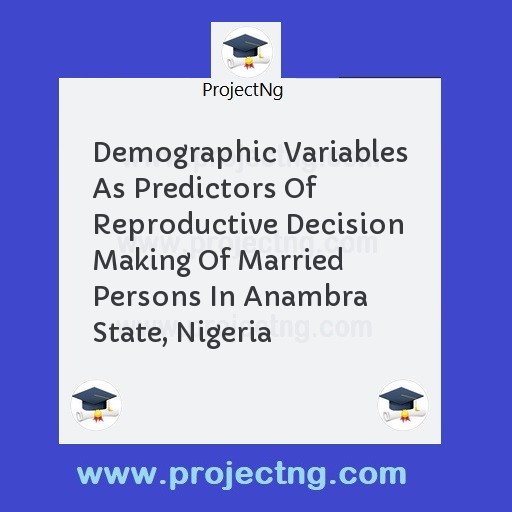Demographic Variables As Predictors Of Reproductive Decision Making Of Married Persons In Anambra State, Nigeria
Education Project Topics
Get the Complete Project Materials Now! »
DEMOGRAPHIC VARIABLES AS PREDICTORS
OF REPRODUCTIVE DECISION MAKING
OF MARRIED PERSONS IN ANAMBRA
STATE, NIGERIA
ABSTRACT
This study sought to explore demographic variables predictive powers of
reproductive decision making of married persons in Anambra State of
Nigeria. Four research questions guided the study while four hypotheses were
equally tested. A correlational design was used for the study. A cluster
sampling procedure involving simple random sampling techniques by
balloting was adopted to compose the sample of 2,250 married persons: 1,125
males and 1,125 females. A structured questionnaire titled: Reproductive
Decision Making Questionniare used to collect data from the respondents.
The data collected were analyzed using multiple regression analysis to test
the hypotheses at 0.05 levels of significance. The analysis of the data yielded
the following results: Demographic variables (education, location, occupation
and income level) significantly predict the reproductive decision making of
married persons in terms of family size (and child spacing); demographic
variables (education, location, occupation and income level) significantly
predict the reproductive decision making of married persons in terms of
contraceptive use; demographic variables (education, location, occupation
and income level) significantly predict the reproductive decision making of
married persons in terms of breastfeeding; demographic variables (education,
location, occupation and income level) significantly predict the reproductive
decision making of married persons in terms of sex preference. Among the
educational implications of the findings of the study was that married persons
could be helped to take joint reproductive decision in terms of family size and
child space, the use of contraceptives, breastfeeding and sex preference. It
was thus recommended that marriage counsellors should help married
persons in their reproductive decision making regarding the use of
contraceptive, family planning, breastfeeding and sex preference, through
organizing seminars, workshops and enlightenment campaign. Suggestions
for further research and limitations were also given.
13
CHAPTER ONE
INTRODUCTION
Background of the Study
The institution of marriage is as old as the history of man and his
creation. Marriage is a traditional institution, which legally unites a man and
a woman to become husband and wife, cohabiting in a household. It is a
traditional institution because it has existed from the immemorial and has
processes and rules guiding it depending on the community where it is done.
In Igbo Land, marriage is not just a union of two persons, towns or
communities involved become and call themselves in-laws. Marriage (also
called matrimony or wedlock) is a socially or ritually recognized union or
legal contract between spouses that establishes rights and obligations between
them and their children, and between them and their in-laws. The definition
of marriage varies according to different cultures, but it is principally an
institution in which interpersonal relationships, usually sexual, are
acknowledged. In some cultures, marriage is recommended or considered to
be compulsory before pursuing any sexual activity. When defined broadly,
marriage is considered a cultural universal (Skynner, 2006). Individuals may
marry for several reasons, including legal, social, libidinal, emotional,
financial, spiritual, and religious purposes. Who they marry may be
influenced by socially determined rules of incest, prescriptive marriage rules,
parental choice and individual desire. In some areas of the world arranged
marriage, child marriage, polygamy, and sometimes forced marriage, may be
1
14
practiced as a cultural tradition. Conversely, such practices may be outlawed
and penalized in many parts of the world out of concerns for human rights
and because of international law. In developed parts of the world, there has
been a general trend towards ensuring equal rights within marriage for
women and legally recognizing the marriages of interracial, interfaith, and
same gender married persons. Oftentimes, these trends have been motivated
by a desire to establish equality and uphold human rights (Martin, 2008).
Marriage can be recognized by a state, an organization, a religious
authority, a tribal group, a local community or peers. It is often viewed as a
contract. Civil marriage is a marriage without religious content carried out by
a government institution in accordance with marriage laws of the,
jurisdiction, and recognized as creating the rights and obligations intrinsic to
matrimony. Marriages can be performed in a secular civil ceremony or in a
religious setting via a wedding ceremony. The act of marriage usually creates
normative or legal obligations between the individuals involved, and any
offspring they may produce. In terms of legal recognition, most sovereign
states and other jurisdictions limit marriage to opposite-sex married persons
and a diminishing number of these permit polygamy, child marriages, and
forced marriage. Over the twentieth century, a growing number of countries
and other jurisdiction have lifted bans on and have established legal
recognition for interracial marriage, interfaith marriage and most lately,
same-sex marriage. Some cultures allow the dissolution of marriage through
divorce or annulment. In some areas, child marriages and polygamy may
15
occur in spite of national laws against the practice (Anameze, 1996). Since
the late twentieth century, major social changes in Western countries have led
Be the First to Share On Social

Enjoying our content?
Don't miss out on new videos! Subscribe to our YouTube channel for more awesome content.
Subscribe Now!













